-
|
Monthly
electronic news bulletin for the marine life of the NE Atlantic Oceans
including the seas and seashore around the British Isles.
The
bulletin is designed for Microsoft Explorer 4 and above using medium fonts
at a resolution of 800 x 600 and can be viewed satisfactorily at a resolution
of 1024 x 768.
Subscribe
and unsubscribe options are at the foot of this page.
|
|
If
you receive this bulletin as an EMail subscriber, you may find the best
way to view the file is on your hard disc in your directory of Incoming
EMails.
|
| MARINE
LIFE NEWS
Reports
of marine wildlife from all around the British Isles, with pollution incidents
and conservation initiatives as they affect the flora and fauna of the
NE Atlantic Ocean

14
March 2010
Thousands
of Common Starfish,
Asterias
rubens, were washed up on the strandline
on the shingle beach at
Budleigh
Salterton in south Devon (East
Devon AONB). The line of washed up starfish
stretched for over a mile.
Starfish
at Budleigh Salterton
Photographs
by Tony Herbert
on flickr
Their
usual residence would be feeding on the mussel
beds offshore. From a previous occurrence underneath the chalk cliffs east
of Brighton Marina,
Sussex, it is my surmise that the mass migration occurs because the Common
Starfish have exceeded their food supply offshore.
Perhaps, this occurs because of commercial dredging of the mussels.
BMLSS
Starfish
17-22
February 2010
A
17 metre long Fin
Whale, Balaenoptera
physalis, was spotted by Jean
Lawson floating about three kilometres off
the shore of north Cornwall. The dead mammal then floated north-east until
five days later the huge whale washed up in a cove near Porthtowan,
37 miles away from the first sighting.
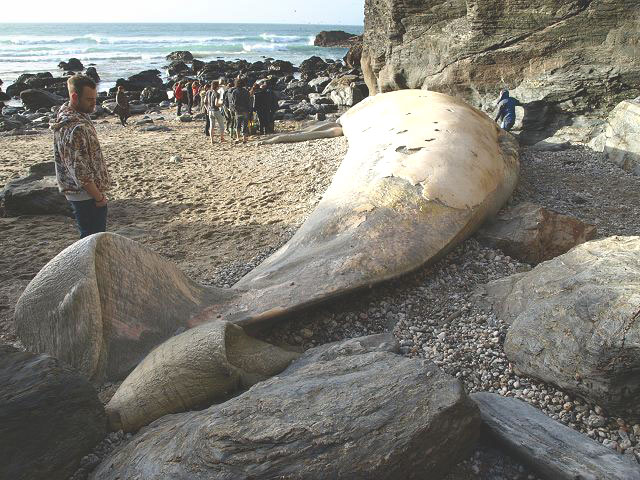
Fin Whale washed
up at Porthtowan
Photograph
by David Fenwick Snr
More
Images
This
is not the first time that the second largest mammal on our planet has
observed drifting with the tides around the British
coast this winter. Another dead Fin Whale
eventually stranded on the Lancashire coast in December
2009.
Previous
Report
Cornish
Wildlife Trust Marine Strandings Network
BMLSS
Cetaceans
-------------------------------------------------------------------------------------------------------------------------
FORUM
NEWS
Marine Wildlife
of the North-east Atlantic Ocean Mailing Groups
Marine
Wildlife of the North-east Atlantic Ocean
Yahoo
Group
New
Group: http://uk.groups.yahoo.com/group/Glaucus
With
the closure of Smart Groups at the end of November
2006
most of the 7500+ messages have been
filed at:
Marine
Wildlife of the North-east Atlantic Ocean Jiglu
http://www.Jiglu.com/spaces/glaucus/
However,
in November 2009,
all these messages were deleted
without warning. Sorry.
This was out of my control.
Images
can be uploaded to flickr.
http://www.flickr.com/groups/glaucus/
Wet
Thumb (Marine Aquariology) Forum Link

------------------------------------------------------------------------------------------------------
All
reports by Andy Horton unless the credits are given
to
other observers or reporters.
Cornish
Marine Wildlife (Ray Dennis Records) 2008
|
| PICTURE
GALLERY
Each
month, at least one special marine image will be published from images
sent to the BMLSS. This
can be of the seashore, undersea world or any aspect of the marine natural
world, especially the underwater life, but not restricted to life beneath
the waves. Topical inclusions may be included instead of the most meritorious,
and images will be limited to the NE Atlantic Ocean and adjoining seas,
marine and seashore species and land and seascapes.
Commensal Organisms
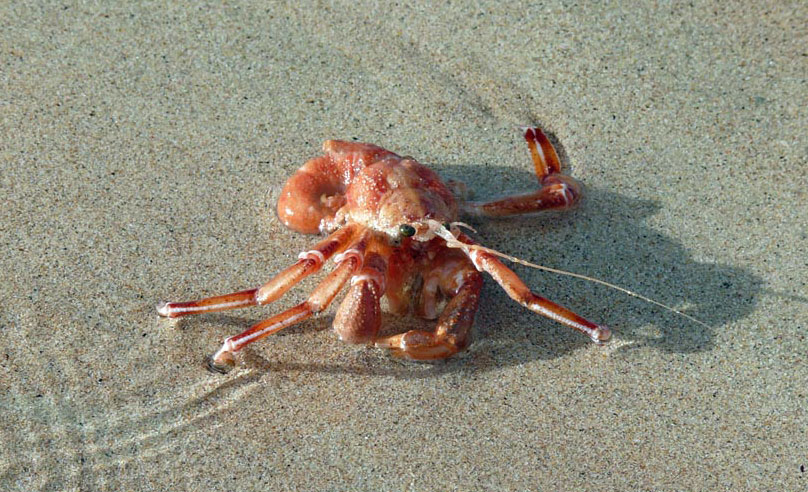
|
Hermit
Crab called Pagurus
prideauxi
Photograph
by Gary Sutherland
One
of the most fascinating aspects of Hermit Crab behaviour is their association
with other animals. The Hermit Crab called
Pagurus
prideauxi shares a mutual relationship
with the Cloak Anemone, Adamsia
palliata. This hermit crab, sans shell,
was discovered on the beach at Oldshoremore,
a couple of miles from Kinlochbervie
in the far north west corner of Scotland. This crab is an unusual discovery
on the shore, the few reports recovered often from Scotland. I
would be interested to hear of any other intertidal reports.
BMLSS
Hermit Crabs
|

|
|
Cloak
Anemone
Photograph
by Gary Sutherland
The
Cloak
Anemone was found on the same beach, but
a little way off. In early life the small adult hermit crab of this species
adopts a gastropod shell like other hermit
crabs but soon after it gains a sea anemone and
the shell dissolves away under the shelter. It is a cold water species
and if its fascinating behaviour is to be observed in an
aquarium
a cooling unit is essential.
BMLSS
Sea Anemones
|
Hermit
Crabs in Torbay
BMLSS
Rockpooling
flickr
BRITISH
MARINE LIFE GALLERY
Shorewatch
Biological Recording
Gallery
-------------------------------------------------------------------------------------------------------------
Shore
Topography Series
The
name of the particular coast should be included and the grid reference,
if known. Print photographs can be included in Exhibitions
and on the BMLSS Web Sites and electronic publications. Electronic images
in
*.jpg format
can also be considered for the web site. They should not exceed 250K in
size.

The
Geoneedle
at Orcombe Point,
Exmouth,
East Devon (south coast)
Photograph
by Paul Willis
The
Geoneedle at Orcombe Point, Exmouth, Devon, which was unveiled by Charles,
Prince of Wales, on 3 October 2002
to mark the western end of the Jurassic
Coast, a World Heritage Site. It is made from a sample of each of the
different rock types along the Jurassic
Coast.
Rocky's
Time Machine Board Game
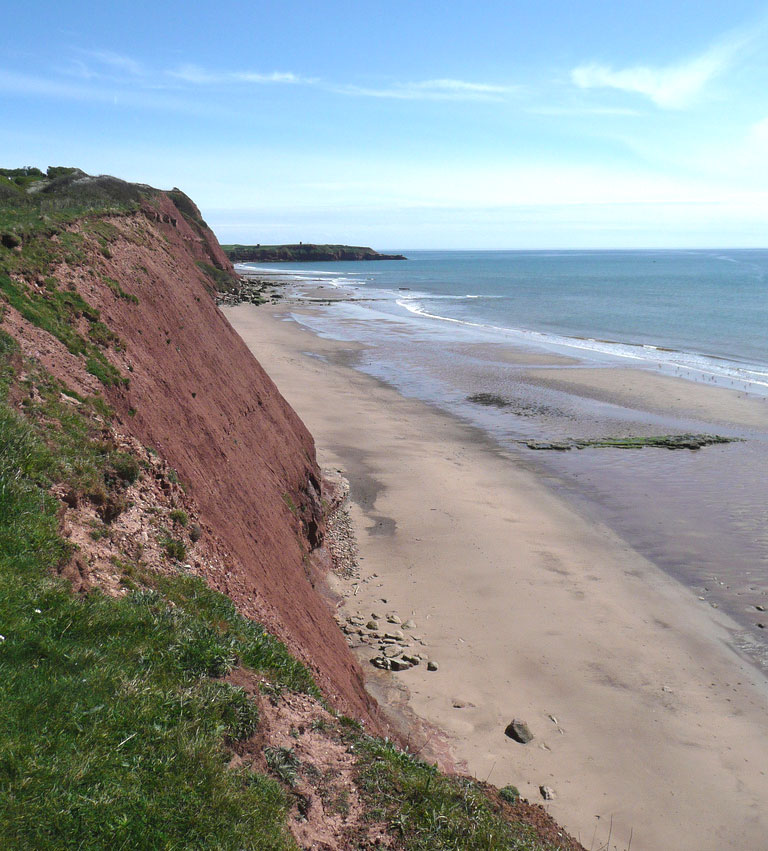
View
towards Sandy Cliff
Photograph
by Paul Willis
Red
cliffs at Littleham
(east of Budleigh Salterton) in Devon on the Jurassic
Coast
The
red cliffs near Budleigh Salterton are notable for the remarkable Budleigh
Salterton Pebble Beds of Triassic age. The Permo-Trias red bed facies of
mudstones, sandstones and pebbles beds contain many interesting features
that have developed in the harsh desert environments of the Pangaea supercontinent.
These include ventifacts or dreikanter, rhizoconcretions and, at Littleham
Cove, radioactive nodules or concretions containing uranium and vanadium
and many metallic elements.
Budleigh
Salterton, Littleham Cove and Straight Point, Devon (Dorset and East Devon
World Heritage Coast) : Geology of the Wessex Coast
flickr
British
Coastal Topography
--------------------------------------------------------------------
First
enquiry by EMail to Glaucus@hotmail.com

-----------------------------------------------------------------------
Photographers
submitting pictures should indicate if they wish them to be considered
for inclusion as confirming permission takes work and time and can delay
publication of the news bulletins.

Click
on the album for more links (On-line link)
|
DIARY
In
chronological order, the most recent events are at the top of the page.
Events open to the public, free or for a nominal charge only are included.
Most Seminars need to be booked in advance.
--------------------------------------------------------------------------------------------------------------
Porcupine
MARINE
NATURAL HISTORY SOCIETY
9-11
April 2010
Event:
Annual Meeting & Field (Intertidal) & Dive Trips
Venue:
Bute
Building, University of St Andrews
Theme:
Changing Seas
Costs:
The conference fee, which includes tea and coffee, is £30 (£20
for students and unwaged). Non-Porcupine members may join the Society during
the conference (by standing order only) for £5, a 50% reduction.
If you wish to take advantage of this offer the total fee will be £35.
Full
Details
(click
on this text)
Bell
Pettigrew Museum of Natural History
Gatty
Marine Laboratory
----------------------------------------------------------------------------
Adur
World Oceans Day 2010
Participation
of other environmental groups are welcome for Adur
World
Oceans
Day 2010 in Shoreham-by-Sea.
This is an interactive exhibition and all stalls need to be manned. Tables,
chairs and an electrical supply are provided. To allocate
space,
we will need to know of exhibitors in advance.
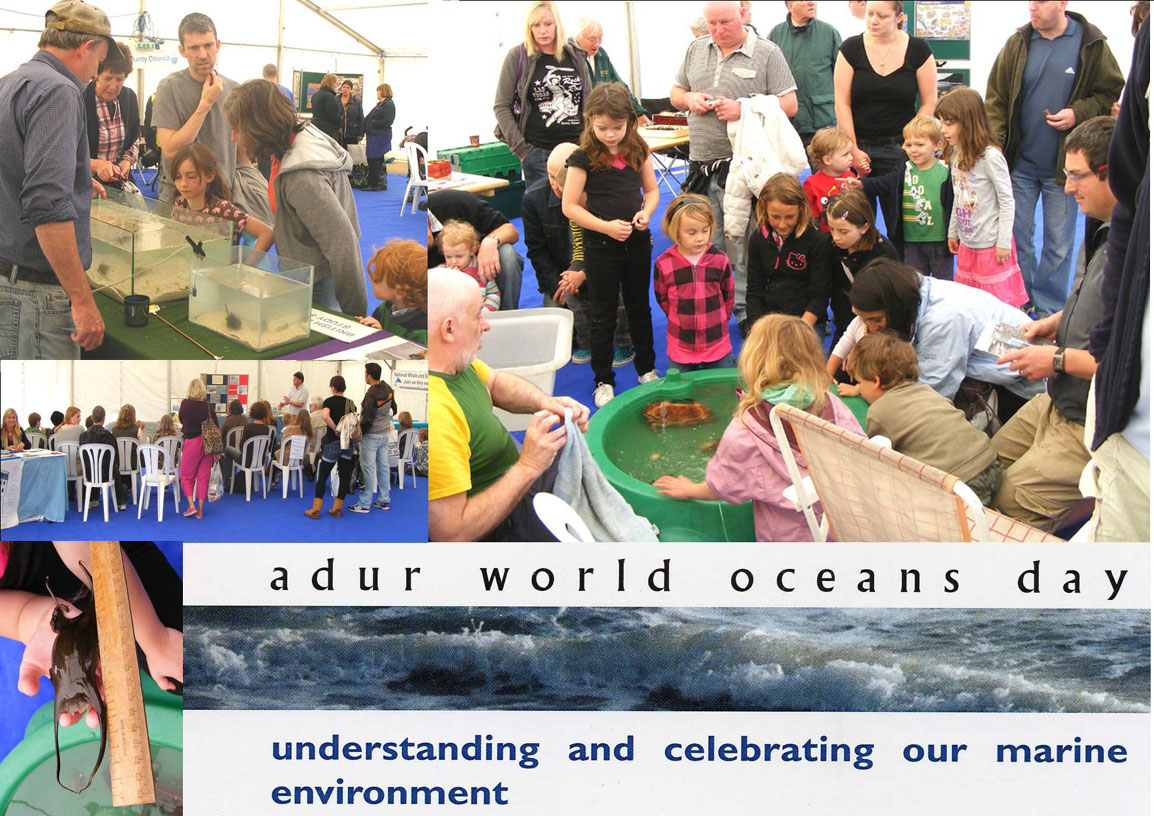
The
for this year is 5 June 2010.
This will be the 14th consecutive year that this exhibition has been held.
-----------------------------------------
BIOSIS
Conference Calendar for Zoology
(Major
Link of all biological conferences around the world)
|
| PUBLIC
AQUARIA NEWS |
| Public
Aquaria List |
| CETACEAN
NEWS |
|
? What
to do if you find a stranded whale or dolphin ?
|
If
you find a LIVE stranded or injured whale or dolphin on the beach you must
send for help QUICKLY. A whale or dolphin stranding is an emergency and
the speed of response by a professional rescue team is perhaps the most
crucial factor in determining whether or not an animal can be returned
to the sea alive.
|
ENGLAND
|
WALES
|
SCOTLAND
|
|
0300 1234
999
|
0300 1234
999
|
0131 339
0111
|
|
CORNWALL
|
JERSEY
|
GUERNSEY
|
|
0845 201
2626
|
01534 724331
|
00 44 1481
257261
|
LINK
TO THE STRANDINGS PAGE
|
PUBLICATIONS
&
WEB PAGES
-----------------------------------------------------------------------------------------------------------------------
BOOKS
PUBLICATIONS
Kimmeridge Tidings
(Autumn 2009)
http://www.dorsetwildlifetrust.org.uk/c2/uploads/tidingsautumn09web.pdf
Up
to date with all the latest happenings at our Purbeck
Marine Wildlife Reserve in Kimmeridge.
VIVARIUM
by
Peter Stiles
Publisher:
Museum
of Barnstaple and North Devon
Philip
Henry Gosse was a popular naturalist who moved to Victorian Ilfracombe
and wrote his natural science book ‘A
Naturalist’s Rambles on the Devonshire Coast’. He later designed the
first public aquarium, which opened in London. His activities also attracted
other naturalists, including Charles Darwin and novelist George Eliot.
This
book celebrates the link between Philip Henry Gosse and his rockpool
adventures in Devon and contains lots of information about the life of
this self-taught Victorian scientist and writer.
in
conjunction with an Exhibition
that finished on 25 April 2009.
Marine
Fisheries Science Yearbook 2008/2009
Publisher:
defra
href="http://archive.defra.gov.uk/search/results.htm?cx=014361324438485032053%3Aljunwq2pe_y&cof=FORID%3A11&ie=UTF-8&q=Marine+Fisheries+Science+">To
obtain a copy from the defra web site, click on this text
 |
Sharks
in British Seas
Richard
Peirce
138
pages, colour illustrations, line drawings, colour & b/w photos.
Lots
of newspaper reports.
Publisher:
Shark Cornwall
Softcover
|
2008 | £9.99
ISBN:
978-0-955869402
|
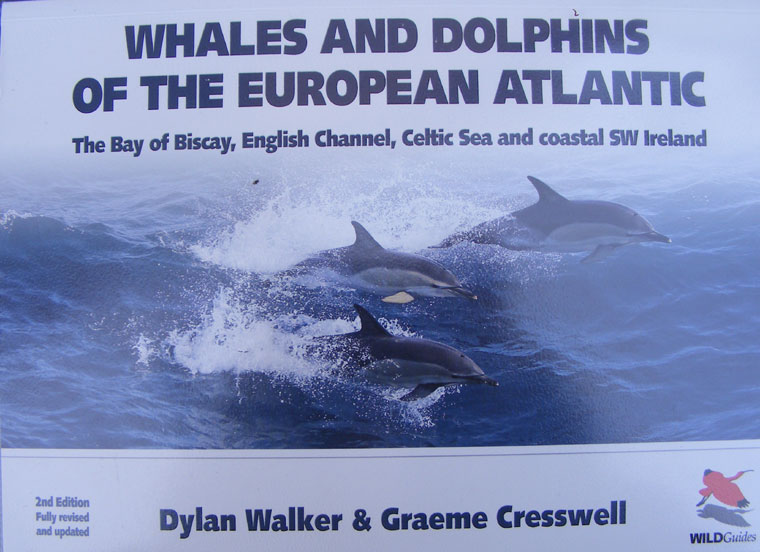
Whales
& Dolphins
of
the European Atlantic
The
Bay of Biscay, English Channel, Celtic Sea and coastal SW Ireland
by
Dylan Walker and Graeme Cresswell
with
the illustrations by Robert Still
WILDGuides
2008
£
12.00 (includes standard UK P&P)
ISBN:
978-1-903657-31-7
This
is the second fully revised and updated edition of this comprehensive guide
to the identification of whales, dolphins and porpoises (collectively known
as cetaceans) in the European Atlantic. Until very recently, most researchers
and whale-watchers were unaware of the great variety of cetaceans that
can be seen so close to the shores of western Europe. Indeed, it is only
during the last decade, when detailed cetacean surveys have been carried
out in earnest, that we have discovered how important this area is for
cetacean biodiversity.
This
field guide describes all of the 31 species of whale, dolphin and porpoise
that have occurred in the European Atlantic.
BMLSS
Cetacean Book Reviews
The
Gulf Stream
by
Bruno Voituriez
Publisher:
UNESCO
ISBN:
92-3-103995-4
222
pages, figures, glossary, bibliography
The
Gulf Stream
Amid
contemporary scenarios of potential climatic catastrophes and global warming
that might be imagined to bring a new ice age, the powerful image of the
Gulf Stream rising from the Florida Straits and flowing to the north Atlantic
inevitably provokes questions about its ecological significance and whether
it might ever stop.
Coastal
Plankton
Photo Guide for
European Seas
by
Otto Larink & Wilfried Westheide
reviewed
by Wim van Egmond
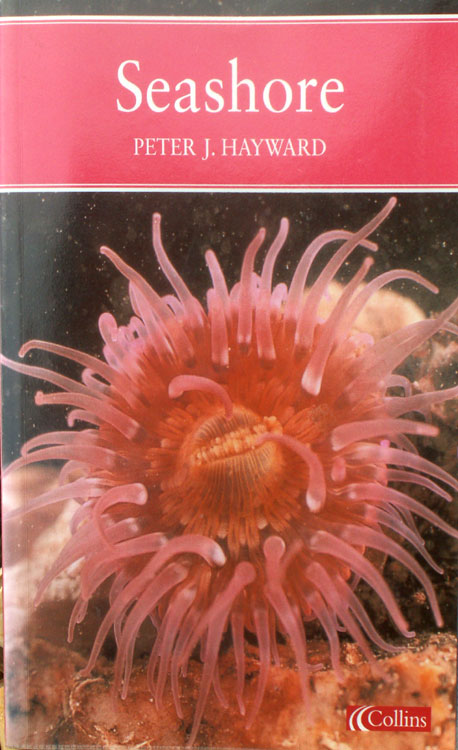 |
Seashore
(Collins
New Naturalist) (Paperback)
by
Peter Hayward
Collins
2004
ISBN:
0-00-220031-7
Amazon
Web Site |
Paperback.
Pp 288. Colour & b/w photographs, illustrations, charts, maps and bibliography.
Fine copy. "New Naturalist" Seashore is a comprehensive, authoritative
account of the natural history of the seashore.
BMLSS
General Guides
BMLSS
Advanced Guides
.
JOURNALS:
SAVE
OUR SEABIRDS NETWORK
Working
to reduce Marine Pollution and to help the birds caught in it
Quarterly
Newsletter
Registered
Charity 803473
--------------------------------------------------------------------------------------------------------------------
WEB
SITES
Decision-making
in Marine Mammal
Rescue
and Rehabilitation
Eastern
English Channel Habitat Atlas for Marine Resource Management
is
available for download from
http://charm.canterbury.ac.uk/atlas/pge.htm
Encyclopaedia
of Marine Life of Britain and Ireland
http://www.habitas.org.uk/marinelife/index.html?item=about
Marine
Fauna of Norway
http://www.seawater.no/fauna/e_index.htm

WET
THUMB (Marine Aquariology)
EFORUM
PAGE
BMLSS:
Marine Life Articles in Publications (Link)
|
SOCIETY
INFORMATION
The
British Marine Life Study Society are responsible for producing the journal
GLAUCUS,
which is the first publication exploring the marine life of the seas surrounding
the British Isles available to the general public. In
future, I expect the publication to be in an electronic format.
-------------------------------------------------------------------------------------------------------------------------
EMail Address
 EMail
address for messages to the British Marine Life Study Society EMail
address for messages to the British Marine Life Study Society
----------------------------------------------------------------------------------------------
Membership 2010
Plans
have not yet been finalised for the publications and subscriptions for
year 2010. Back copies of previous issues are still available.
|
|
Bulletin
Details
If
you receive this Bulletin direct from the British Marine Life Study Society
it will contain only hypertext and image (*.htm *.gif & *.jpg) files.
Recipients
can only unsubscribe if the Bulletin is received directly from the
BMLSS.
Permission
is granted to forward the Bulletin on unaltered. However, you will have
to include the images separately.
Subscribe/Unsubcribe
http://groups.yahoo.com/group/BMLSS-Torpedo
To
save download times, only new images are included with each Bulletin.
The
Bulletin is designed to be viewed on Internet Explorer using medium fonts
at
a resolution of 800 x 600.
Viewing
should be possible on Netscape and other browsers. |
|
Printing
the two column version of Torpedo (from issue 28)
These
pages are not designed for the default settings on the Page Set-ups of
your browser. I recommend viewing in Microscope Internet Explorer 7 and
altering the right and left hand columns in the Page Set-up menu to 9 mm
(from 19 mm).
The
page set-up can also be amended in Netscape Composer and other web page
editors, and this has the advantage of enabling the specified number of
pages to be printed and the information about the file (name, path, date)
to be deleted.
Some
of the images may not display if you have changed your directory for downloaded
files. The images may also not display properly if your settings on your
EMail software do not allow you do this automatically. When received in
Pegasus the format is changed slightly, but the bulletin is still readable.
|
---------------------------------------------------------------------------------------------------------------------------------
Compiled
on Netscape Composer 4.7 and other programs
|

